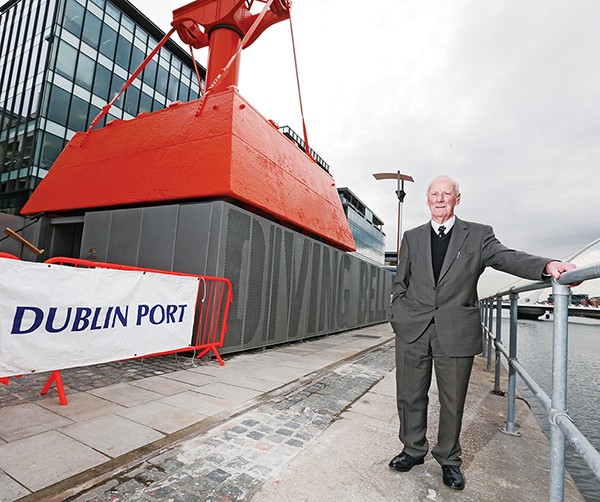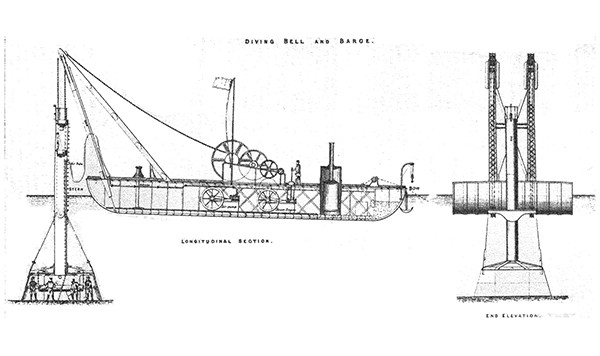
Above: Image of Dermot Heron and the Bell by Conor McCabe.
While strolling along Sir John Rogerson’s Quay you are unlikely to hear the Pink Floyd album of 20 years ago of the same name but you may well be charmed by the glowing re-emergence of an original Diving Bell, which has recently been restored by Dublin Port Company.
In its glowing orange and amber tones, reflecting the sweet Liffey light, you will be treated to a taller structure from its previous, terrestrial incarnation, as it has been placed higher on foundations so that a visitor may enter its belly without worry about subaquatic monsters of the deep.
Wandering closer you will hear the tantalising trickle of a stream underfoot paying tribute to its thalassic history as you garner a glimpse of the tightest exhibition space ever created since the Dawson Lounge.
When in use, men would have been submerged inside its torso to a submarine workplace as they built what are now the walls and structures of the Liffey and Dublin Port walls.

Above: A contemporary diagram from 1878 showing how the bell, controlled from a steam barge, was used for excavation.
Its method of operation entailed lowering it into position on the riverbed, while the crew entered through an access funnel from the surface. Compressed air was fed in from an adjacent barge. The men inside the bell worked on the river bed exposed at their feet, excavating the site where a massive concrete block would later go. All the excavated soil was stashed in trays hanging inside the bell, and brought up when the bell was lifted.
One of these men, Dermot Heron, pictured above, was at the recent opening with Minister for Transport Paschal O’Donoghue and Betty Ashe from St Andrew’s Resource Centre. Heron is the last person remaining who has worked inside the Diving Bell.
NewsFour also came across young Sofia and Micheál Kelleher, whose father Jim was project manager of the restoration. Sofia, beaming with pride about her father, informed us it was her third visit to the exhibition since opening.
Eamonn O’Reilly, Chief Executive of Dublin Port Company said: “Dublin Port Company is proud to bring the Diving Bell to life for Dubliners and visitors to the city. Our restoration project pays tribute to Bindon Blood Stoney, who built the deep water quays in Dublin in the Victorian era. It also commemorates the generations of port employees who worked in the bell. It invites the city’s visitors and inhabitants, new and old, to better understand Dublin as a port city with a wealth of industrial heritage to uncover.” He also added that “the Diving Bell is the first of a series of important industrial heritage exhibits we plan to create in the years ahead.”
The project was designed with the expertise of a range of people including the architect Sean O’Laoire, the sculptor Vivienne Roche, Tom Cosgrave (professor of engineering at the University of Limerick) and the late Mary Mulvihill of Ingenious Ireland.
By Ferg Hayden

